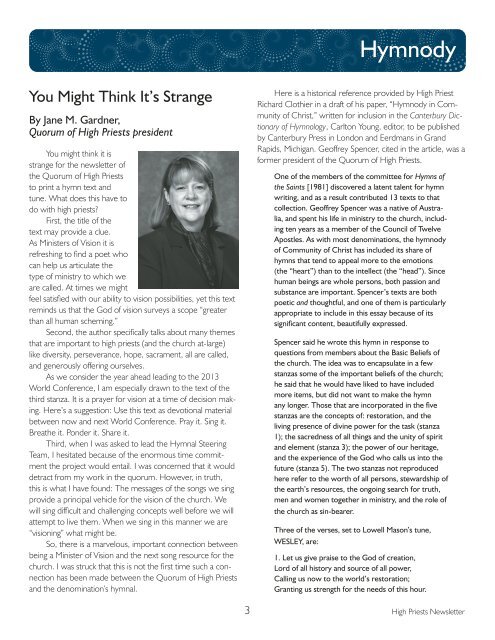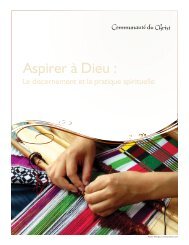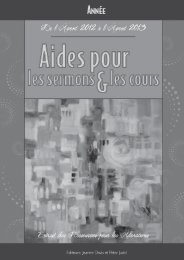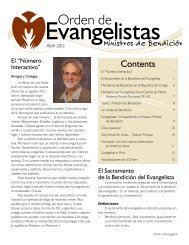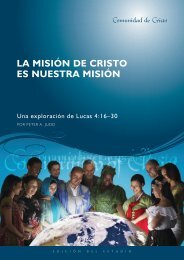Leading Congregations in Mission - Community of Christ
Leading Congregations in Mission - Community of Christ
Leading Congregations in Mission - Community of Christ
You also want an ePaper? Increase the reach of your titles
YUMPU automatically turns print PDFs into web optimized ePapers that Google loves.
You Might Th<strong>in</strong>k It’s Strange<br />
By Jane M. Gardner,<br />
Quorum <strong>of</strong> High Priests president<br />
You might th<strong>in</strong>k it is<br />
strange for the newsletter <strong>of</strong><br />
the Quorum <strong>of</strong> High Priests<br />
to pr<strong>in</strong>t a hymn text and<br />
tune. What does this have to<br />
do with high priests?<br />
First, the title <strong>of</strong> the<br />
text may provide a clue.<br />
As M<strong>in</strong>isters <strong>of</strong> Vision it is<br />
refresh<strong>in</strong>g to f<strong>in</strong>d a poet who<br />
can help us articulate the<br />
type <strong>of</strong> m<strong>in</strong>istry to which we<br />
are called. At times we might<br />
feel satisfied with our ability to vision possibilities, yet this text<br />
rem<strong>in</strong>ds us that the God <strong>of</strong> vision surveys a scope “greater<br />
than all human schem<strong>in</strong>g.”<br />
Second, the author specifically talks about many themes<br />
that are important to high priests (and the church at-large)<br />
like diversity, perseverance, hope, sacrament, all are called,<br />
and generously <strong>of</strong>fer<strong>in</strong>g ourselves.<br />
As we consider the year ahead lead<strong>in</strong>g to the 2013<br />
World Conference, I am especially drawn to the text <strong>of</strong> the<br />
third stanza. It is a prayer for vision at a time <strong>of</strong> decision mak<strong>in</strong>g.<br />
Here’s a suggestion: Use this text as devotional material<br />
between now and next World Conference. Pray it. S<strong>in</strong>g it.<br />
Breathe it. Ponder it. Share it.<br />
Third, when I was asked to lead the Hymnal Steer<strong>in</strong>g<br />
Team, I hesitated because <strong>of</strong> the enormous time commitment<br />
the project would entail. I was concerned that it would<br />
detract from my work <strong>in</strong> the quorum. However, <strong>in</strong> truth,<br />
this is what I have found: The messages <strong>of</strong> the songs we s<strong>in</strong>g<br />
provide a pr<strong>in</strong>cipal vehicle for the vision <strong>of</strong> the church. We<br />
will s<strong>in</strong>g difficult and challeng<strong>in</strong>g concepts well before we will<br />
attempt to live them. When we s<strong>in</strong>g <strong>in</strong> this manner we are<br />
“vision<strong>in</strong>g” what might be.<br />
So, there is a marvelous, important connection between<br />
be<strong>in</strong>g a M<strong>in</strong>ister <strong>of</strong> Vision and the next song resource for the<br />
church. I was struck that this is not the first time such a connection<br />
has been made between the Quorum <strong>of</strong> High Priests<br />
and the denom<strong>in</strong>ation’s hymnal.<br />
Hymnody<br />
Here is a historical reference provided by High Priest<br />
Richard Clothier <strong>in</strong> a draft <strong>of</strong> his paper, “Hymnody <strong>in</strong> <strong>Community</strong><br />
<strong>of</strong> <strong>Christ</strong>,” written for <strong>in</strong>clusion <strong>in</strong> the Canterbury Dictionary<br />
<strong>of</strong> Hymnology, Carlton Young, editor, to be published<br />
by Canterbury Press <strong>in</strong> London and Eerdmans <strong>in</strong> Grand<br />
Rapids, Michigan. Ge<strong>of</strong>frey Spencer, cited <strong>in</strong> the article, was a<br />
former president <strong>of</strong> the Quorum <strong>of</strong> High Priests.<br />
One <strong>of</strong> the members <strong>of</strong> the committee for Hymns <strong>of</strong><br />
the Sa<strong>in</strong>ts [1981] discovered a latent talent for hymn<br />
writ<strong>in</strong>g, and as a result contributed 13 texts to that<br />
collection. Ge<strong>of</strong>frey Spencer was a native <strong>of</strong> Australia,<br />
and spent his life <strong>in</strong> m<strong>in</strong>istry to the church, <strong>in</strong>clud<strong>in</strong>g<br />
ten years as a member <strong>of</strong> the Council <strong>of</strong> Twelve<br />
Apostles. As with most denom<strong>in</strong>ations, the hymnody<br />
<strong>of</strong> <strong>Community</strong> <strong>of</strong> <strong>Christ</strong> has <strong>in</strong>cluded its share <strong>of</strong><br />
hymns that tend to appeal more to the emotions<br />
(the “heart”) than to the <strong>in</strong>tellect (the “head”). S<strong>in</strong>ce<br />
human be<strong>in</strong>gs are whole persons, both passion and<br />
substance are important. Spencer’s texts are both<br />
poetic and thoughtful, and one <strong>of</strong> them is particularly<br />
appropriate to <strong>in</strong>clude <strong>in</strong> this essay because <strong>of</strong> its<br />
significant content, beautifully expressed.<br />
Spencer said he wrote this hymn <strong>in</strong> response to<br />
questions from members about the Basic Beliefs <strong>of</strong><br />
the church. The idea was to encapsulate <strong>in</strong> a few<br />
stanzas some <strong>of</strong> the important beliefs <strong>of</strong> the church;<br />
he said that he would have liked to have <strong>in</strong>cluded<br />
more items, but did not want to make the hymn<br />
any longer. Those that are <strong>in</strong>corporated <strong>in</strong> the five<br />
stanzas are the concepts <strong>of</strong>: restoration, and the<br />
liv<strong>in</strong>g presence <strong>of</strong> div<strong>in</strong>e power for the task (stanza<br />
1); the sacredness <strong>of</strong> all th<strong>in</strong>gs and the unity <strong>of</strong> spirit<br />
and element (stanza 3); the power <strong>of</strong> our heritage,<br />
and the experience <strong>of</strong> the God who calls us <strong>in</strong>to the<br />
future (stanza 5). The two stanzas not reproduced<br />
here refer to the worth <strong>of</strong> all persons, stewardship <strong>of</strong><br />
the earth’s resources, the ongo<strong>in</strong>g search for truth,<br />
men and women together <strong>in</strong> m<strong>in</strong>istry, and the role <strong>of</strong><br />
the church as s<strong>in</strong>-bearer.<br />
Three <strong>of</strong> the verses, set to Lowell Mason’s tune,<br />
WESLEY, are:<br />
1. Let us give praise to the God <strong>of</strong> creation,<br />
Lord <strong>of</strong> all history and source <strong>of</strong> all power,<br />
Call<strong>in</strong>g us now to the world’s restoration;<br />
Grant<strong>in</strong>g us strength for the needs <strong>of</strong> this hour.<br />
3 High Priests Newsletter


